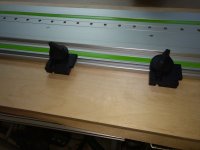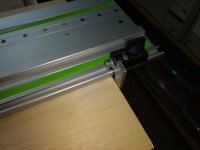mattbyington
Member
- Joined
- Mar 11, 2018
- Messages
- 796
Hey Team,
Okay, admittedly, this question is going to be very basic. Apologies in advance.
So, in another thread, I mentioned I purchased the Domino DF 500 Set. It arrived yesterday (thanks Bob!).
I haven't gotten a chance really to play with it yet but I was thinking about lining everything up.
I've been watching this video as a tutorial for essentially a shelving unit (I'm actually making toolbox drawer dividers, but same joinery technique as in the video).
=219s
If I want "shelves" (read: dividers) spaced EXACTLY evenly across the face of the panel lying down (3:39 on the video), here's my question:
Normally when you use the domino horizontally, you reference the fence height to determine where along the edge of a board the domino is (like he does at 7:29).
However - back at 3:39 - the distance from the bottom of the domino to the center of the cutting instrument is exactly 10mm right?
Does that mean that at his cut at 7:29, the fence height MUST be set to 10mm (always) regardless of how thick the vertical panel is (the one receiving dominos on the edge)?
It's a little hard to grok because in the video, he is just illustrating placing the "shelf" *anywhere* on the flat panel, but in my case, I want to plan specifically for exactly spaced shelves and that means that the mortise position is really important.
I hope the question makes sense - sorry if it doesn't ... trying to figure this Domino thing out!!
Best, thanks as always,
Matt
Okay, admittedly, this question is going to be very basic. Apologies in advance.
So, in another thread, I mentioned I purchased the Domino DF 500 Set. It arrived yesterday (thanks Bob!).
I haven't gotten a chance really to play with it yet but I was thinking about lining everything up.
I've been watching this video as a tutorial for essentially a shelving unit (I'm actually making toolbox drawer dividers, but same joinery technique as in the video).
=219s
If I want "shelves" (read: dividers) spaced EXACTLY evenly across the face of the panel lying down (3:39 on the video), here's my question:
Normally when you use the domino horizontally, you reference the fence height to determine where along the edge of a board the domino is (like he does at 7:29).
However - back at 3:39 - the distance from the bottom of the domino to the center of the cutting instrument is exactly 10mm right?
Does that mean that at his cut at 7:29, the fence height MUST be set to 10mm (always) regardless of how thick the vertical panel is (the one receiving dominos on the edge)?
It's a little hard to grok because in the video, he is just illustrating placing the "shelf" *anywhere* on the flat panel, but in my case, I want to plan specifically for exactly spaced shelves and that means that the mortise position is really important.
I hope the question makes sense - sorry if it doesn't ... trying to figure this Domino thing out!!
Best, thanks as always,
Matt





